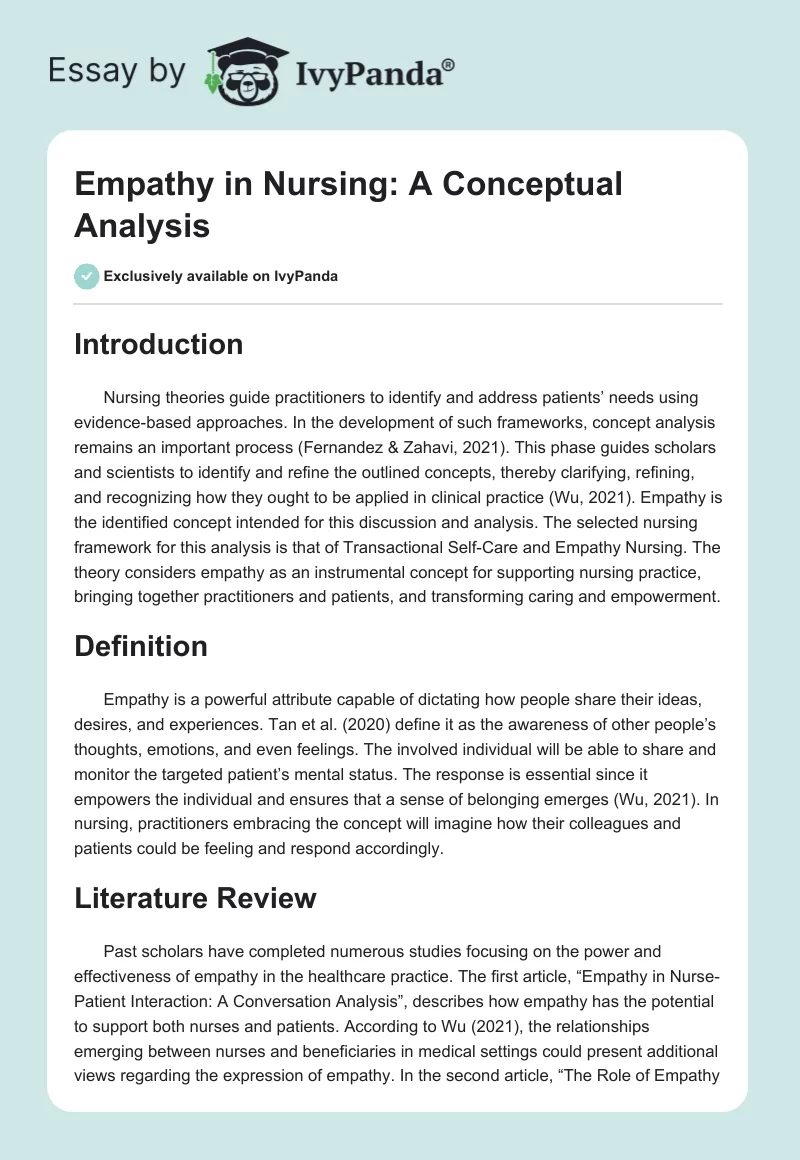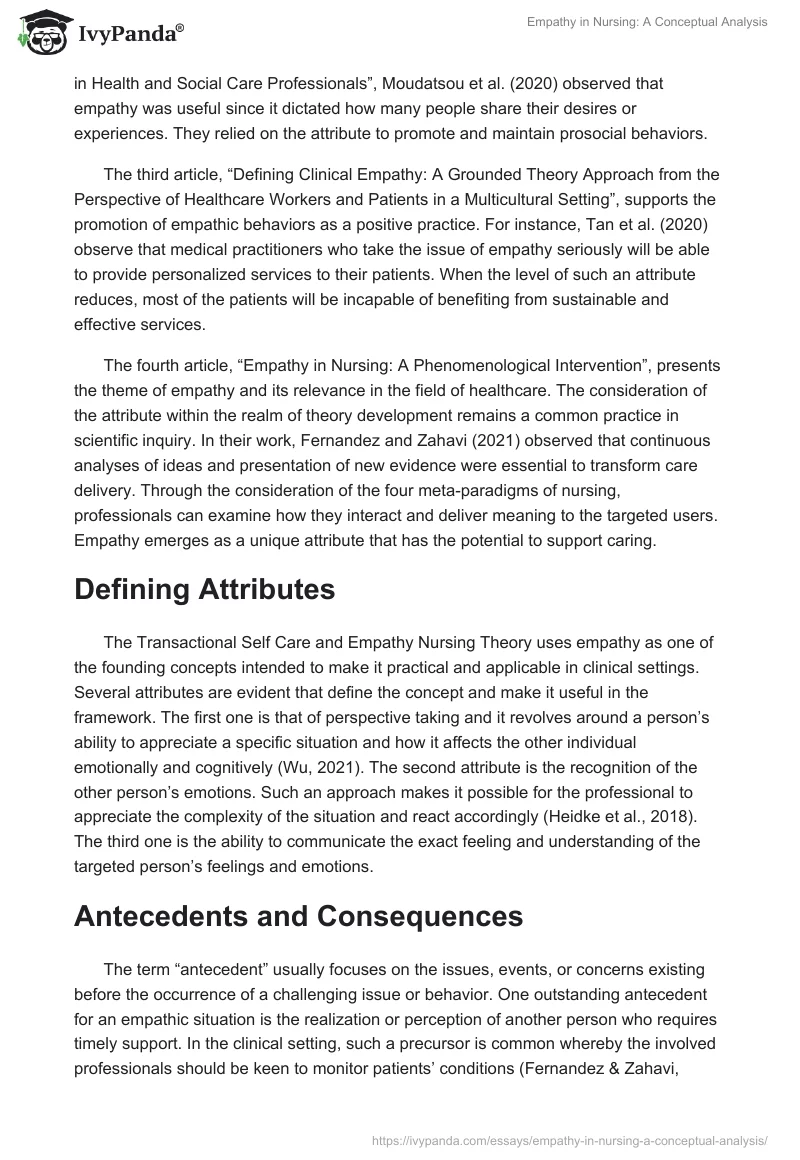Introduction
Nursing theories guide practitioners to identify and address patients’ needs using evidence-based approaches. In the development of such frameworks, concept analysis remains an important process (Fernandez & Zahavi, 2021). This phase guides scholars and scientists to identify and refine the outlined concepts, thereby clarifying, refining, and recognizing how they ought to be applied in clinical practice (Wu, 2021). Empathy is the identified concept intended for this discussion and analysis. The selected nursing framework for this analysis is that of Transactional Self-Care and Empathy Nursing. The theory considers empathy as an instrumental concept for supporting nursing practice, bringing together practitioners and patients, and transforming caring and empowerment.
Definition
Empathy is a powerful attribute capable of dictating how people share their ideas, desires, and experiences. Tan et al. (2020) define it as the awareness of other people’s thoughts, emotions, and even feelings. The involved individual will be able to share and monitor the targeted patient’s mental status. The response is essential since it empowers the individual and ensures that a sense of belonging emerges (Wu, 2021). In nursing, practitioners embracing the concept will imagine how their colleagues and patients could be feeling and respond accordingly.
Literature Review
Past scholars have completed numerous studies focusing on the power and effectiveness of empathy in the healthcare practice. The first article, “Empathy in Nurse-Patient Interaction: A Conversation Analysis”, describes how empathy has the potential to support both nurses and patients. According to Wu (2021), the relationships emerging between nurses and beneficiaries in medical settings could present additional views regarding the expression of empathy. In the second article, “The Role of Empathy in Health and Social Care Professionals”, Moudatsou et al. (2020) observed that empathy was useful since it dictated how many people share their desires or experiences. They relied on the attribute to promote and maintain prosocial behaviors.
The third article, “Defining Clinical Empathy: A Grounded Theory Approach from the Perspective of Healthcare Workers and Patients in a Multicultural Setting”, supports the promotion of empathic behaviors as a positive practice. For instance, Tan et al. (2020) observe that medical practitioners who take the issue of empathy seriously will be able to provide personalized services to their patients. When the level of such an attribute reduces, most of the patients will be incapable of benefiting from sustainable and effective services.
The fourth article, “Empathy in Nursing: A Phenomenological Intervention”, presents the theme of empathy and its relevance in the field of healthcare. The consideration of the attribute within the realm of theory development remains a common practice in scientific inquiry. In their work, Fernandez and Zahavi (2021) observed that continuous analyses of ideas and presentation of new evidence were essential to transform care delivery. Through the consideration of the four meta-paradigms of nursing, professionals can examine how they interact and deliver meaning to the targeted users. Empathy emerges as a unique attribute that has the potential to support caring.
Defining Attributes
The Transactional Self Care and Empathy Nursing Theory uses empathy as one of the founding concepts intended to make it practical and applicable in clinical settings. Several attributes are evident that define the concept and make it useful in the framework. The first one is that of perspective taking and it revolves around a person’s ability to appreciate a specific situation and how it affects the other individual emotionally and cognitively (Wu, 2021). The second attribute is the recognition of the other person’s emotions. Such an approach makes it possible for the professional to appreciate the complexity of the situation and react accordingly (Heidke et al., 2018). The third one is the ability to communicate the exact feeling and understanding of the targeted person’s feelings and emotions.
Antecedents and Consequences
The term “antecedent” usually focuses on the issues, events, or concerns existing before the occurrence of a challenging issue or behavior. One outstanding antecedent for an empathic situation is the realization or perception of another person who requires timely support. In the clinical setting, such a precursor is common whereby the involved professionals should be keen to monitor patients’ conditions (Fernandez & Zahavi, 2021). They will then consider the best ways to identify and respond to the identified empathic concern. Without such an antecedent, it would be impossible to apply the notion and eventually transform the experience of the targeted individual.
After realizing that a specific patient needs empathic support and acting accordingly, one possible consequence would be that of improved satisfaction. Heidke et al. (2018) indicate that the presence of such a concept creates room for relief, thereby improving the patient’s trust level. The beneficiary will remain involved and willing to share more with the caregiver. The possible outcome is that the level of patient satisfaction, characterized by better-coping approaches, will increase. The patient will eventually benefit from the available care delivery procedures in the specific facility.
Empirical Referents
In theory development and application, empirical referents play a crucial role since they help users identify possible categories of the predicted phenomena evidenced by the occurrence of a specific concept. For empathy, the first possible empirical referent would be that of behavioral resonance. Wu (2021) identifies it as the shared feelings of concern, mutual support, and positivity. The second empirical referent associated with empathy is the vicarious response to emotions. These would be characterized by several aspects, such as the power to attend, listen, or accept (Moudatsou et al., 2020). Such attributes can guide users of nursing theory to determine whether empathy is evident or missing in a given healthcare setting or patient-nurse relationship.
Construct Cases
Model Case
Jimmy has been hospitalized for two weeks with a broken left leg. Although he has received the relevant medical support, Nurse John finds him crying because he might take a long before being on his feet again. John tries to comfort him but he remains inconsolable. He decides to give him a clean and sterilized face towel and brings him some warm water. John creates more time for him to reflect and calm down. He comes back after two hours and communicates with him while in the hospital bed. He promises to remain involved and consider how he could help him throughout the treatment process. He liaises with his family members and explains why they need to remain supportive.
From the case, John appears empathic, involved, and ready to offer the best support. He follows the unique attributes described above. He is keen to put himself in the shoes of Jimmy and focuses on his feelings. Through such an approach, John succeeds in validating the needed emotions and relieving Jimmy’s tension. He responds perfectly to the patient’s concerns (Tan et al., 2020). He liaises with the individual to ensure that nothing has been missed. He liaises with the family members.
Borderline Case
In a pediatric ward, a mother is breastfeeding a baby aged six months who has been admitted with pneumonia. The young woman asks the available nurse to spare some time because she has a special request to make. The nurse comes to the bedside and focuses on her appeal. After a short conversation, the nurse learns that the mother is concerned about her other child who is with her aunt back at home. She seems concerned and worried that the young girl could be stressed. The nurse asks how she could help in such a situation. The baby’s mother requests the nurse to assist her with her mobile phone to make a call to her sister, the girl’s aunt. While she accepts the request, she instructs the lady not to borrow her phone in the future.
This borderline case reveals that only some form of empathy is evident in the relationship between the baby’s mother and the nurse. While the nurse remains concerned and creates time to listen to the individual’s needs, she remains detached emotionally. The promoted calm atmosphere does not empower the client in the hospital setting (Moudatsou et al., 2020). The nurse fails to make further inquiries about the situation. The nurse could have responded more effectively and without having to compel the women to consider looking for a phone from elsewhere.
Contrary Case
Mrs. Martin is in the outpatient department where she has come for a routine medical procedure. The involved professionals appear to have disliked her for being too inquisitive. Being an elderly woman, she uses hearing aids to communicate with others more effectively. This day she meets an unconcerned and uninvolved practitioner. The professional picks up her phone and starts talking about her previous vacation experience. It takes around forty minutes to complete the conversation before focusing on Mrs. Martin’s laboratory results. She writes the relevant prescriptions without uttering a word to her.
This case could be studied as a contrary practice when it comes to the idea of empathy. The involved practitioner ignored the affective and cognitive abilities to empathize with the patient. She was reluctant to communicate more effectively with the patient. This form of disregard and inability to learn more about the patient’s health issues resulted in a borderline case (Tan et al., 2020). The absence of empathy affected the quality of concern and care available to the individual.
Application
Transactional self-care has become more meaningful and applicable in a wide range of nursing practices. The concept of empathy is one of the concepts associated with their framework and it has the potential to meet the needs of both practitioners and patients. Fernandez and Zahavi (2021) indicate that practitioners need to recognize the concept since it promotes the process of caring. It supports the promotion of a transaction approach to care whereby professionals express a willingness to learn more about patients’ emotions.
The selected advanced practice area is that of clinical nurse specialist. Through the power of empathy, it will be possible to identify, engage, and learn more about the emotions and feelings of the targeted patients. From the completed concept analysis, it will be possible to consider the outlined attributes of empathy (Wu, 2021). The outlined antecedents will become the best ideas for focusing on positive consequences. In clinical nursing, specialists will apply the concept by focusing on key attributes associated with the described model case. The selected theory would ensure that caring expression becomes the norm.
Conclusion
The concept of empathy has remained instrumental in nursing practice since it creates the best environment for positive patient-nurse relationships. The attributes outlined in the concept analysis above could become powerful guidelines for identifying antecedents and focusing on the best consequences. The described model case presents a guideline for promoting the outlined concept to meet changing patients’ needs. Such an approach will, therefore, set the stage for desirable nurse-patient interactions, thereby resulting in high-quality services.
References
Fernandez, A., & Zahavi, D. (2021). Empathy in nursing: A phenomenological intervention. Tetsugaku, 5, 23-39. Web.
Heidke, P., Howie, V., & Ferdous, T. (2018). Use of healthcare consumer voices to increase empathy in nursing students. Nurse Education in Practice, 29, 30-34. Web.
Moudatsou, M., Stavropoulou, A., Philalithis, A., & Koukouli, S. (2020). The role of empathy in health and social care professionals. Healthcare, 8(1), 26-34. Web.
Tan, L., Le, M. K., Yu, C. C., Liaw, S. Y., Tierney, T., Ho, Y. Y., Lim, E., Lim, D., Ng, R., Ngeow, C., & Low, J. (2020). Defining clinical empathy: A grounded theory approach from the perspective of healthcare workers and patients in a multicultural setting. BMJ Open, 11(9). Web.
Wu, Y. (2021). Empathy in nurse-patient interaction: A conversation analysis. BMC Nursing, 20(1), 18-23. Web.


